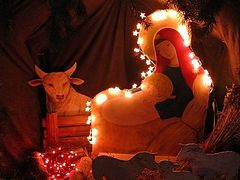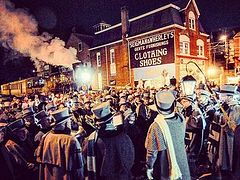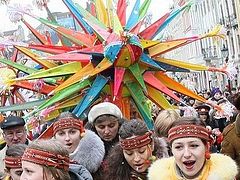The two weeks between the feast of the Nativity of Christ and His Theophany have in Orthodox lands always been a time spent glorifying Christ in families and communities. With this spilling over of joy in the birth of our Savior came the tradition of walking from house to house singing carols, to bring the grace and peace of Christ’s Nativity to those around us. In Slavic lands this is called “Kolyadki”, and in Greece they are called “Kalanta”. In looking over various videos on this theme—our favorite of which we have posted below—we could not help but notice many similarities in these traditions.
This is a wonderful time especially for children, since the most traditional songs are also very simple and easy to sing. The children sing outside their neighbors’ houses, and the adults express their gratitude and love for them by putting sweets or coins in their hands and purses.
Some of our choices are ancient, while others combine the old traditions with the new. For example, this Christmas video from a primary school in Athens, Greece:
There are very few strictly northern Russian kolyadi, since Russians usually adhered strictly to the Nativity hymns sung in church. But they are making up for it with new Christmas songs of their own. Here is one sung by a child, with our translation of the lyrics in English. Try singing it with your own children!
The Stars Shone So Brightly
O, how the stars shone so brightly
High over Bethlehem town,
Quiet the flocks in the fields lay,
Everywhere peaceful and calm.
Refrain:
Born on this night is Jesus the Babe,
Us suffering people He came here to save.
My praises I sing, only to Him,
My Jesus, my Christ!
Angels in heavenly radiance
Hymned their bright glory to Christ,
But all the houses were full then,
So He was born in the crèche.
O Jesus come down and stay here,
Here in my little child’s heart,
I am a lamb, You’re my Shepherd,
In heaven, may we never part.
Romania has its own very sober but melodious tradition of caroling. Notice how close the words are to the Greek kalanta, beginning with the children’s gracious appeal to the nobility with Christmas and New Year wishes, and humble request for gifts. “They bring you no harm, but they bring God to you,” sing the carolers as they process through the village.
There are so many absolutely heartwarming Ukrainian kolyadki that it is hard to choose only one. Here is children’s kolyadki video from the Ukraine that we could watch again and again. It’s called “The Angels Flew In”. It begins, “The Angels flew in, like birds from Heaven, and all the children sing joyously as is meet: “Hey, hey! O Jesus! Hey, hey! Glory! The shepherds are awake, from night to early morn…” The children sing to the newborn Lord, and hasten in mind and heart to the manger…
Another popular Ukrainian kolyadka is called “A New Joy Has Come”. Here a group of carolers sing, carrying the Christmas star and manger scene, through a Carpathian village.
Also in the Carpathian Mountains, “Dobry Vecher Tobiy”—“Good Evening, Sir”. The children address the villagers respectfully, proclaiming, “Be joyful all the Earth, for the Son of God is Born!” and receive their longed-for sweets.
And another song from Carpathian children, “In the Fields”:
In Serbia, adults and children sing together of the “Bright day of the Lord” with their traditional Christmas bread in hand. Notice how in both the Ukrainian and Serbian tradition, (as also in some Russian regions) the carolers throw wheat to their listeners as a wish for prosperity, and as a symbol of Christ, the “Bread of Life”.
This Serbian Christmas song is effervescent with joy in the birth of Christ the Savior:
In Georgia there is a tradition of processing on Christmas through the town wearing special festive garb, singing “Allilo” (Alleluia). It looks like this:
There are also entirely modern Christmas songs being sung in Georgia, such as this one by composer Tamaz Jorbenadze:
Bulgaria has its own unique tradition of singing praises throughout the town of Christ’s coming to Earth. One can hear their closeness to Byzantium, and their strict adherence to an ancient Nativity tradition. A group of men or boys process arms linked through the village in a dance-walk, praising Christ’s birth, spreading the glad tidings to all and wishing them the peace of Christ. Their regal movement is reminiscent of the same forward procession that the Magi and shepherds made toward Christ in Bethlehem. This is how it looks in a Bulgarian village at a traditional Christmas “koledare” as it is called in Bulgarian (Again, they are casting wheat to the listeners):
Here is the ancient Bulgarian “koledara”, with our approximate translation of the beginning:
Honoring the Nativity of Christ
The Eternal God came down,
And abode in the Virgin,
Refrain:
Holy, Holy, Holy, Most Holy art Thou, O Lord!
The King and Lord sleeps
Come to transform Adam. (Refrain)
Ye choirs rejoice and exalt,
And ye angels rejoice. (Refrain)
Your Lord has come to Bethlehem,
Your King and Master. (Refrain).
The Magi come from the East,
To bring worthy gifts. (Refrain).
And they worship the Lord
Born in the cave. (Refrain).
<…>
The song ends with a prayer to the Theotokos:
“O Mother most pure, Save the Christian race!”
From Greece to Russia, the old-world Orthodox have always loved to spread the glad tidings like the angels to their friends and neighbors as a symbol of the whole inhabited earth. May the joy of Christ’s Nativity, His coming to the world to save mankind, come also to your hearts in these blessed days!




https://www.youtube.com/watch?v=uFnmFiTJlpY
Rejoice!